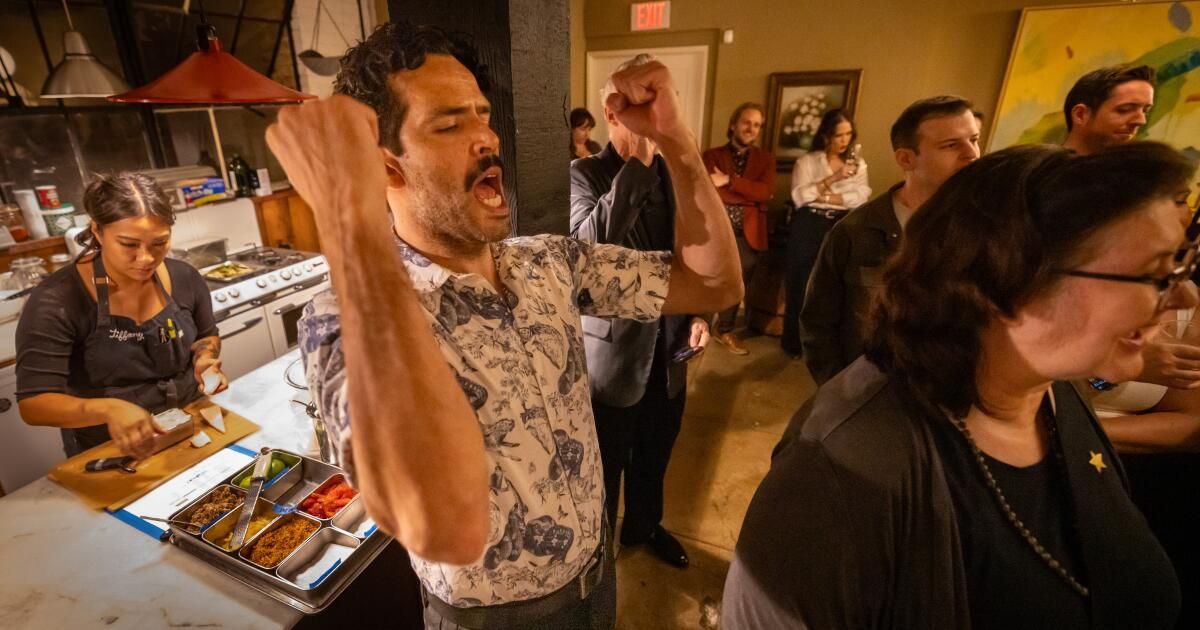Most dining experiences aim to eliminate chaos and create a perfectly elegant night out. “Family Meal,” however, wants to make it clear.
We'd been told we were here to attend a retirement party of sorts, one last meal for an acclaimed chef before he turns over his 26-year-old restaurant. What unfolds is a battle between their children for exclusive ownership, and the night becomes, in the words of one of the brothers, “a culinary fight.” Bad words are thrown around. Recipes are slandered. A parent will regularly dismiss, speak down to, or belittle their offspring.
The house's fictional chef-patriarch, Shelley Landwald, orders each of her children to prepare a signature dish for us guests, one that declares, “This is who I am. This is the future.” My table of strangers look at each other apprehensively, now that it's clear that this night won't be quiet and completely seated.
Chef Shelley Landwald (Neill Fleming) is giving one last hurray in “Family Meal,” an interactive theater show currently playing in Los Angeles.
(Jason Armond / Los Angeles Times)

Chef Ben Barron (right), the real chef behind “Family Meal,” hands out appetizers to guests attending the experience.
(Jason Armond / Los Angeles Times)
“Family Meal” is a modern update of the old idea of dinner and a show, only this dinner theater presentation isn't just about drinks, dinner, and passive entertainment. A production by immersive theater company Speakeasy Society in association with chef Ben Baron's Order/Fire Productions, the show hopes to appeal to those who have become accustomed to movies like Anthony Bourdain's “Kitchen Confidential,” “The Bear” and other high-energy looks behind the scenes of the restaurant business.
The night begins in a dignified manner. A check-in at an elegant residence and then a brief reception with other guests. Some reflect on wine pairing. Others try to find information about the mysterious six-course dinner. They tell me it's been too long since I last visited, and I make excuses for my absence.

Matthew Schaler, right, and chef Ben Barron, left, are two of the real cooks on “Family Meal.” Guests can see them in action.
(Jason Armond / Los Angeles Times)

“Family Meal” offers attendees an exclusive six-course meal amidst an interactive theater show.
(Jason Armond / Los Angeles Times)
But soon we run from our seats to the kitchen and back, pondering not only the ingredients but also the family gossip. “We're here tonight for the food,” Landwald, played by Neill Fleming, tells us. “Me too”.
An ego like that can only mean disorder and disorder will follow, and “Family Meal” delivers. But it does so with unexpected, high-end food. The resulting evening will have as reference “King Lear” and gastronomic reality shows. It's tense, but through the stress is the fact that we are here to play, interact and participate.
“We had to walk the line between the brashness and sometimes raw nature of kitchen culture,” says Matthew Bamberg-Johnson, co-artistic director of the Speakeasy Society with Julianne Just and Genevieve Gearhart.
“While we wanted to pull back the curtain a little bit, we didn't want to completely attack guests with it while they're enjoying their delicious food. There are parts that are tense. There are parts that are uncomfortable. That's by design,” Bamberg-Johnson says.

The characters of Shelley Landwald (Neill Fleming) and Jozef Landwald (Chris Mollica) in a tense scene in “Family Meal,” which explores the dysfunction of the restaurant and the home.
(Jason Armond / Los Angeles Times)

A look at the dining room setup for “Family Meal,” an interactive theater show that explores the stress of a life working on food.
(Jason Armond / Los Angeles Times)
“Family Meal” manages to walk that delicate line throughout its three-hour experience, ultimately leading us to more closely consider the character of our meal. Perhaps we're given a delicious plate of greens (mixed lettuce, roasted squash, fried garlic, and a touch of acidity courtesy of blood oranges), only to later witness a sibling dispute over its preparation and validity. A salad? Mocked as a pedestrian.
We may be tapped on the shoulder and dragged into the kitchen during the meal, suddenly embroiled in a heated debate over an ingredient, or assigned to do some minor kitchen work (emphasis on the minor). After all, we're not here to organize salad ingredients or try a sauce, even if we suddenly find ourselves enjoying a preserved lime and green peppercorn dressing. We are here to discover the secrets of a dysfunctional family, led by a chef who has been hiding more than a few. There are multiple narrative threads that will come together in the show's final act, but guests won't be able to witness them all.
“I think it's an important juxtaposition: Here you have a beautiful dish in front of you, and now you can take a look at the behind-the-scenes cost of making this beauty that you can consume,” Gearhart says.

Duck is served as the fifth course in “Family Meal”. The plate occupies an important place in the narrative of the performance, as each plate is designed to reflect a character or personality from the story.
(Jason Armond / Los Angeles Times)
That cost depends largely on real-life chef Baron, who designed the show's menu and whose resume includes stints at Petit Trois, Bestia and Roberta's, among others. Today, Baron is primarily a private chef and restaurant consultant, but the idea for “Family Meal” was his. After visiting New York and seeing the now-closed immersive theater show “Life & Trust,” which was the latest from Emursive, producers of Punchdrunk’s “Sleep No More,” Baron says he fell in love with theater in which guests try out how to choose their own adventure.

The Speakeasy Society and Order/Fire Productions present “Family Meal.” The show is expensive to produce and the team used crowdfunding to help cover production costs.
(Jason Armond / Los Angeles Times)
“I remember being on set and saying, 'This is so cool that I can have my own experience within this Faustian experience,'” Baron says of “Life & Trust.” “How can I do this in a restaurant?”
In March, she connected with Speakeasy, which, in addition to her local immersive theater work, has also collaborated with artists like experiential art collective Meow Wolf. “Family food” emerged relatively quickly. Baron drew recipes and experiences from his own experience. Dishes, for example, like fried bread with black garlic and goat cheese, reference their Hungarian heritage, while the drama explores the dichotomy (the invisible “battles,” in Baron's words) between the front and back of the restaurant. Only in “Family Meal” they sometimes overflow.
But beyond the cursing and passive aggressiveness, there are also parts we can identify with, or maybe those are actually the parts we can identify with. “I've heard a lot of people say, 'Wow, this was Tuesday at my house,'” Bamberg-Johnson says.
For Speakeasy, the challenge was pacing. “Family Meal” is first and foremost a spectacle, but Baron pushed for guests to be able to enjoy their meal in silence, allowing them to chat with each other or meet other participants.
“It was very important to Ben that people have time to talk about their day, talk about each other and catch up,” says Gearhart.
My favorite moments were the ways the show asks us to reflect on the dishes, which “Family Meal” tries to align with the personalities of the characters who prepare them. The aforementioned fry bread, for example, is an almost dessert-like donut that arrives between the salad and the duck entree. It provokes a strong reaction of disgust from the production's fictional chef.
“These are some of the comments about the industry,” says Baron. “There are different rules for different chefs. Sometimes there are reasons and they are right. Sometimes it just doesn't align with their vision of food.”
It's also a moment taken from Baron's real life. “It's a very real experience where I've tried dishes that I know are really interesting (or sometimes aren't) and a chef will get mad because you tried something new. It depends on the guest. I've had some people tell me it's their favorite dish. Some people have just told me they don't like goat cheese.”

The characters of Anna Landwald (Claire Chapelli) and Shelley Landwald (Neill Fleming) surrounded by the audience in “Family Meal.” The show is interactive and encourages guests to lean in and participate.
(Jason Armond / Los Angeles Times)

A croquette served as the second course of the “Family Meal”. Each course is designed to tell a mini story.
(Jason Armond / Los Angeles Times)
“Family food” is not an easy experience to produce. Speakeasy helped finance it through a crowdfunding site, raising about $21,000 for production costs. And while ticket prices for shows in the local immersive scene have steadily increased, Speakeasy and Baron are charging a premium price for “Family Meal.” Tickets start at $340 per person, and the team knows some may be upset by the cost.
“If you go out to a nice dinner and buy a ticket to the Pantages, you're spending just as much, if not more, on an experience that's not as intimate or gives you a chance to be a part of the story itself,” Bamberg-Johnson says, noting that even with the ticket price, they had to seek crowdfunding due to production costs.
If all goes well, “Family Meal” will become a regular show on the local scene. Speakeasy is already looking at options to bring it to Palm Springs or elsewhere, and is thinking about seasonal menus in hopes that audiences will return a second time. Gearhart theorizes that there is enough content for at least three separate viewings of the production, depending on which actors the audience chooses to follow.
But one step at a time.
“People have been burned by expensive experiences with embedded foods in the past, where they may not have been an equal character on the show,” Bamberg-Johnson says. “So this is a risk.”
The bet, however, is that the chaos that occurs in the kitchen generates an intense and irresistible drama.

The character of Shelley Landwald (Neill Fleming) is at the center of the drama of “Family Meal.”
(Jason Armond / Los Angeles Times)












